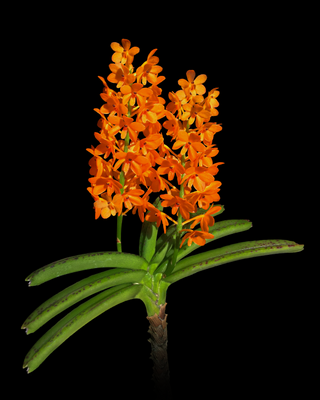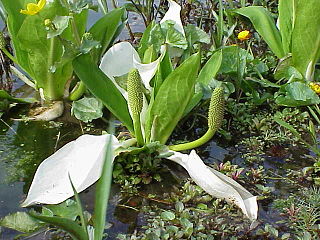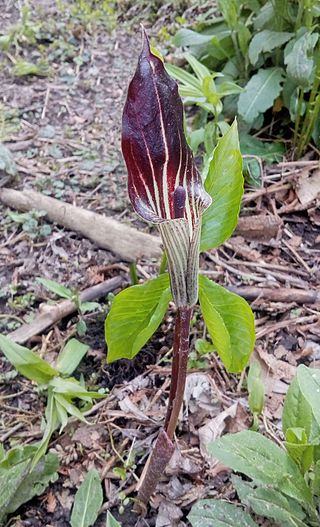
The Araceae are a family of monocotyledonous flowering plants in which flowers are borne on a type of inflorescence called a spadix. The spadix is usually accompanied by, and sometimes partially enclosed in, a spathe. Also known as the arum family, members are often colloquially known as aroids. This family of 140 genera and about 4,075 known species is most diverse in the New World tropics, although also distributed in the Old World tropics and northern temperate regions.

Amorphophallus is a large genus of some 200 tropical and subtropical tuberous herbaceous plants from the Arum family (Araceae), native to Asia, Africa, Australia and various oceanic islands. A few species are edible as "famine foods" after careful preparation to remove irritating chemicals. The genus includes the Titan arum of Indonesia, which has the largest inflorescence of any plant in the genus, and is also known as the 'corpse flower' for the pungent odour it produces during its flowering period, which can take up through seven years of growth before it occurs.

A raceme or racemoid is an unbranched, indeterminate type of inflorescence bearing flowers having short floral stalks along the shoots that bear the flowers. The oldest flowers grow close to the base and new flowers are produced as the shoot grows in height, with no predetermined growth limit. Examples of racemes occur on mustard and radish plants.

Philodendron is a large genus of flowering plants in the family Araceae. As of September 2015, the World Checklist of Selected Plant Families accepted 489 species; other sources accept different numbers. Regardless of number of species, the genus is the second-largest member of the family Araceae, after genus Anthurium. Taxonomically, the genus Philodendron is still poorly known, with many undescribed species. Many are grown as ornamental and indoor plants. The name derives from the Greek words philo- or "love, affection" and dendron or "tree". The generic name, Philodendron, is often used as the English name.

Anthurium is a genus of about 1,000 species of flowering plants, the largest genus of the arum family, Araceae. General common names include anthurium, tailflower, flamingo flower, and laceleaf.

Zantedeschia is a genus of eight species of herbaceous, perennial, flowering plants in the family Araceae, native to southern Africa from South Africa north to Malawi. The genus has been introduced on all continents except Antarctica. Common names include arum lily for Z. aethiopica and calla and calla lily for Z. elliottiana and Z. rehmannii, although members of the genus are neither true lilies of Liliaceae, true Arums, nor true Callas. The colourful flowers and leaves of both species and cultivars are greatly valued and commonly grown as ornamental plants.

Lysichiton is a genus in the family Araceae. These plants are known commonly as skunk cabbage or less often as swamp lantern. The spelling Lysichitum is also found. The genus has two species, one found in north-east Asia, the other in north-west America.

Arisaema triphyllum, the jack-in-the-pulpit, bog onion, brown dragon or Indian turnip, is a herbaceous perennial plant growing from a corm. It is a highly variable species typically growing 30–65 centimetres (12–26 in) in height with three-part leaves and flowers contained in a spadix that is covered by a hood. It is native to eastern North America, occurring in moist woodlands and thickets from Nova Scotia west to Minnesota, and south to southern Florida and Texas.

Carrion flowers, also known as corpse flowers or stinking flowers, are mimetic flowers that emit an odor that smells like rotting flesh. Apart from the scent, carrion flowers often display additional characteristics that contribute to the mimesis of a decaying corpse. These include their specific coloration, the presence of setae and orifice-like flower architecture. Carrion flowers attract mostly scavenging flies and beetles as pollinators. Some species may trap the insects temporarily to ensure the gathering and transfer of pollen.

Arum is a genus of flowering plants in the family Araceae, native to Europe, northern Africa, and western and central Asia, with the highest species diversity in the Mediterranean region. Frequently called arum lilies, they are not closely related to the true lilies Lilium. Plants in closely related Zantedeschia are also called "arum lilies".

Aglaonema is a genus of flowering plants in the arum family, Araceae. They are native to tropical and subtropical regions of Asia and New Guinea. They are known commonly as Chinese evergreens.

Callopsis is a monotypic genus from the plant family Araceae and has only one species, Callopsis volkensii. This plant forms a creeping rhizome and has cordate-ovate leaves that are medium green and glaborous. The inflorescence is typical of the family Araceae, with a white spathe and yellow spadix. The spadix is shorter than the spathe and its male and female flowers are separated shortly.

Homalomena is a genus of flowering plants within the family Araceae. Homalomena are primarily found in southern Asia and the southwestern Pacific, but there are a few species that are known to be indigenous to Latin America. Many Homalomena have a strong smell of anise. The name derives apparently from a mistranslated Malayan vernacular name, translated as homalos, meaning flat, and mene = moon.

Thaumatophyllum bipinnatifidum is a plant in the genus Thaumatophyllum, in the family Araceae. Previously it was classified in the genus Philodendron within subgenus Meconostigma. The commonly used names Philodendron bipinnatifidum and Philodendron selloanum are synonyms. This plant is native to South America, namely to Brazil, Bolivia, Argentina, and Paraguay, but is also cultivated as a landscape plant in tropical, subtropical and warm temperate climates.

Anubias afzelii is a species belonging to the Aroid genus Anubias. It was first described scientifically by Heinrich Wilhelm Schott in 1857, based on material collected in Sierra Leone by Adam Afzelius, after whom the species was named. The genus Anubias was described simultaneously, with only A. afzellii belonging to it, which therefore is the type species of the genus. No other species currently placed in the genus Anubias was described earlier and A. afzelii was therefore the first species of this genus known to science.

Arisarum vulgare, common name the friar's cowl or larus, is an herbaceous, perennial, rhizomatous plant in the genus Arisarum belonging to the family Araceae.

Anubias hastifolia is a species belonging to the Aroid genus Anubias. It was first mentioned by Adolf Engler in 1889 and described scientifically by him in 1893.

Arum dioscoridis, commonly known as the Spotted arum, is a plant of the arum family (Araceae).

Arum cylindraceum is a woodland plant species of the family Araceae. It is found in most of Europe except the UK, Russia, Ukraine, Belarus, the Baltic States and Scandinavia, and in Turkey. It is also missing in northwestern France and southern Italy.

Arum orientale is a woodland plant species of the family Araceae. It is found in southeastern Europe as far west as Vienna and in Turkey. Its primary range is Romania, Bulgaria, and southern Ukraine.



















